DOES INPUT MATTER? GESTURE AND HOMESIGN IN NICARAGUA, CHINA, TURKEY, AND THE USA
Science does not often have the opportunity to observe the genesis of a natural language. However, in the case of deaf individuals born into hearing families, language genesis can be observed as it happens. Deaf children born into non-signing hearing families often spend their early years unable to access their world's ambient language. In the most extreme case, deaf children who are unable to hear the spoken language surrounding them and who are not exposed to a conventional sign language develop their own gesture systems: homesigns. These homesign systems bear many of the hallmarks of mature languages, including stable word order, arbitrariness, and displaced talk (Goldin-Meadow, 2003, 2005) and grammatical categories (Coppola and Newport, 2005). When circumstances cause homesigners to come together for extended periods of time, the situation is ripe for the creation of a new full-blown language.
The new sign language in Nicaragua is the product of just this sort of situation. Deaf children brought their individual homesign systems with them to new schools founded in the 1970's (Polich, 2005). As they began to gesture and communicate with one another, they converged on a common system: Nicaraguan Sign Language was born. The language is now thriving, with nearly one thousand native users (Senghas & Coppola, 2001). But why did this new language grow so quickly? Though children create homesign systems in the absence of a conventional language, these systems do not arise in a vacuum. The raw materials for a homesign are the child's brain and the only accessible linguistic input in their environment: the gestures of the hearing people around them. Children around the world are born with equivalent mental resources, but the gestural input homesigners have to work with might differ.
In western cultures, hearing parents who have chosen to educate their deaf children orally are advised to use their voices whenever they communicate with their children; as a result, they rarely produce gestures without also producing speech. In contrast, hearing parents not committed to training their deaf children orally might be more open to producing gestures in the absence of speech. And gestures produced without speech have been found to display the linguistic properties of segmentation and hierarchical combination, properties not found in gestures produced along with speech (Goldin-Meadow, McNeill & Singleton, 1996). Homesigners with this more language-like gestural input might create different, perhaps more linguistically complex, gesture systems than children exposed only to gestures that co-occur with speech. Our study takes the first step in exploring this possibility by examining gestural input to homesigners in four different cultures: Nicaragua, Turkey, the USA and China.
Four deaf homesigning children from each culture were observed at play in their homes with members of their family. Sessions were videotaped and coded. All vocal and gestural utterances directed toward the child by a family member were recorded. Utterances were classified based on whether they contained gesture without speech, gesture with speech, or speech alone. All children received utterances of all types, but the proportion varied by culture. The majority of the utterances that the Nicaraguan homesigners received contained gesture without speech (black bars). In contrast, almost all of the gestures that the children in the other three cultures received were produced along with speech (white bars). The American and Turkish children also received a sizeable number of utterances containing only speech (grey bars).
Because the gestures they see are produced without speech, the Nicaraguan homesigners may be getting substantially richer input than the homesigners in other cultures. These gesture-alone utterances may be complex enough to serve as the raw linguistic materials for language creation, allowing the Nicaraguan homesigners to then create more complex homesign systems than those seen in other cultures. If so, the Nicaraguan environment may have been a particularly fertile environment for the birth of a new language, which could help to explain the rapid emergence and development that has been documented in the language over the past few decades.
Note from Publisher: This article contains the abstract only.



